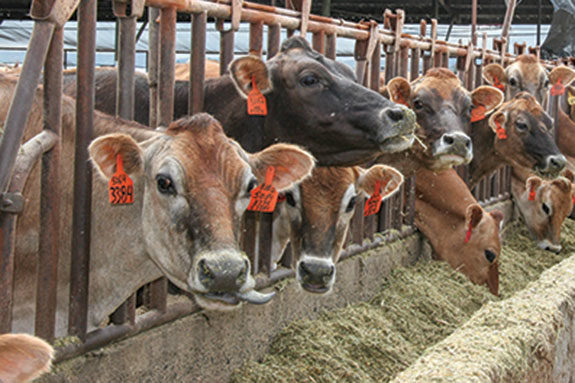While it is often said that on a given farm production will be a function of genetic potential and the meeting of nutrition requirements, in the case of milkfat content, this may not be true.
Analysis of DHIA data, in combination with recent research, suggests that potential for fat production among herds of similar breeding should be comparable and relatively high, and that lower milkfat content may almost exclusively be due to feed factors that increase the production of specific trans fatty acids in the rumen which, in turn, inhibit milkfat output at the mammary gland. Consequently, these effects are likely within our control.
Potential milkfat content is higher than the average
A review of DHI summary reports shows there are relatively small differences in average herd milkfat content (3.7 to 3.8 percent) between regions within Canada and the U.S., despite large differences in diet such as barley silage based in Alberta versus corn silage in southern Ontario and the U.S. Midwest.
{socialbuttons}Perhaps this should not be surprising since the animals probably share a common genetic base given the international nature of today’s semen industry.
Yet, within each region, herd milkfat content is highly variable, often ranging over a 10-point spread. For example, the rolling herd averages for 250 Holstein herds for April 2013 in the Eastern Wisconsin Dairy Herd Improvement Cooperative June newsletter ranged from 5,963 to 16,803 kilograms (11,175 kilograms average) for milk, 3.3 to 4.4 percent (3.7 percent average) for fat and 2.9 to 3.4 percent (3.1 percent average) for protein.
Even though regression analysis showed that milkfat decreased 0.148 percentage units for every 5,000 kilograms of milk production, milk production only accounted for less than 8 percent of the variation in fat content, and the highest-producing herds had above-average milkfat content.
Thus, it could be argued that the potential fat content for herds in a given region might be equivalent to the level achieved by a certain percentile of the top herds with comparable milk production within that region.
Effect of nutrient supply on milkfat production
It is well understood that both milk yield and milk composition are affected by energy and protein supply. However, it has been difficult to understand these effects because they have been generally confounded with simultaneous changes in diet composition, intake and rumen function … until recently.
In a novel experiment in the Journal of Dairy Science, researchers from INRA, in France, fed four groups of Holstein cows (high-producing and low-producing multiparous, and high-producing and low-producing primiparous: 41.7, 34.0, 32.5, 28.5 kilograms per day, respectively) during mid-lactation, a range of diets that varied two steps above as well as below their individual requirements for both energy and protein.
In this study, where both diet composition and dry matter intake were controlled, the researchers clearly demonstrated that “fat content was the only measured response that was not affected by the dietary treatments.” In other words, neither the changes in energy or protein supply, nor the associated changes in milk production, altered milkfat content.
Fat yield, on the other hand, increased with both energy and protein supply as a function of milk yield.
Given the range in forage-to-concentrate ratio and levels of nutrient intake applied in the INRA study, these results appear to support the concept that as long as rumen function is not impaired, dairy cattle will express their potential for milkfat content.
Milkfat content is decreased by trans fatty acids absorbed from the rumen
Extensive research over the last 10 years or so has consolidated our understanding to the point that it is now generally accepted that milkfat depression results from the production of specific “trans” fatty acids in the rumen due to microbial biohydrogenation of polyunsaturated fatty acids (PUFA).
The trans fatty acids are absorbed into the blood and exert their effect in low concentrations at the mammary gland where they quantitatively reduce milkfat secretion.
Dr. Adam Lock of Michigan State University indicates there are three ways in which the amounts of trans fatty acids produced in the rumen, and risk of milkfat depression, can be affected, and each is related to diet and feeding management:
1. Alter the amount of C18 PUFA entering the rumen: Milkfat depression is associated with feeding higher levels of unsaturated fats, such as are found in oils and oilseeds, as well as byproducts such as corn distillers grains.
Feeds such as alfalfa and grass or corn grain can also be substantial sources of PUFAs due to their fatty acid composition and level of inclusion in the diet.
2. Alter the bio-hydrogenation pathways: Milkfat depression has been associated with high-starch feeding, low rumen pH and the feeding of monensin.
It is unclear whether acid load or related changes in the microbial population, or both, may change the biohydrogenation pathways in favour of producing trans fatty acids, since acidosis or low rumen pH need not be a prerequisite for milkfat depression.
3. Alter the rates of biohydrogenation: It is conceivable that diet-induced changes in microbial population and rumen environment could also change the relative rates of biohydrogenation within different pathways.
At the 2013 Western Canadian Dairy Seminar, Lock shared data showing that increasing the level of mono-unsaturated fat in the diet also increased trans fatty acid production.
It remains unclear the extent to which specific dietary factors affect the production of trans fatty acids in the rumen or how these factors may interact to increase the level of production.
Nevertheless, the primary risk factors for reducing potential milkfat content, and thus losing potential fat production, can be simplified as follows: feeding excessive amounts of non-rumen protected unsaturated fat, providing rations that lower rumen pH and feeding monensin, either individually or in combination. Methods to avoid these risks are addressed in the following guidelines.
Guidelines to optimize milkfat production
-
Limit unprotected fat sources: Limit the combined total of all unprotected sources of unsaturated fats, including oils, oil seeds and byproducts such as distillers grains, to 1 pound per head per day or 2 percent of diet dry matter. Use rumen-protected sources for additional supplementation.
- Limit starch: Limit starch levels according to both the type of grain fed and its degree of processing to reduce rate of fermentation and ruminal acid load.
Standards for feeding 27 percent starch or 40 to 42 percent NFC were developed based on feeding cracked or coarsely ground dry corn. Fine grinding of corn breaks down the protein structure around the starch granules that otherwise slows its rate of digestion, making its digestion characteristics comparable to barley.
Barley grain and barley silage diets in Alberta are optimally formulated to maximum NFC of 37 to 38 percent. High-moisture corn is also digested at a faster rate than dry corn as moisture content increases and particle size decreases, and ration NFC levels should be decreased accordingly.
- Provide adequate NDF from forage: Optimally, formulate to a minimum of 21 percent NDF from forage sources to maintain optimal rumen function and rumination. In high-production cows, this is usually achievable only with good-quality forages.
If this number is allowed to drop, especially to meet energy requirements due to poor forage quality, problems with high NFC, rumination and milkfat often appear.
- Prevent ration sorting: To minimize sorting, ensure that the majority of forage particles are sufficiently processed so they pass through the top sieve of the Penn State Particle Separator but are retained on the second sieve, leaving only 3 to 5 percent of the TMR by weight on the top sieve with few, if any, particles more than 2 inches in length.
Conversely, much of today’s sorting problems are due to rations being too dry, such that smaller concentrate and other rapidly digested particles easily sift through the longer forage particles. In these cases, only sufficient addition of water or inclusion of high-moisture ingredients will prevent the sorting and its negative effects on rumen function, chewing and milkfat content.
-
Feed and push up feed more frequently: Feeding at least twice a day and pushing up feed regularly decreases the effectiveness of sorting behaviour.
-
Use bi-carb and yeast: Both bi-carb and yeast have been shown to enhance rumen function and support milkfat content, potentially by limiting the extent of drops in rumen pH following feeding.
- Use monensin with care: While monensin has been shown to improve feed efficiency in lactating dairy cattle, it has also been shown to reduce milkfat content, especially when fed at higher levels and in diets that increase rumen acid load. In these cases, its optimal level of inclusion may need adjustment.
If your herd’s milkfat content is below the upper 25th percentile for your region, it can likely be increased by making changes to either the ration content or its management along the lines given above.
Whether the changes can be made in the short term (e.g., starch levels, fat supplementation) versus the longer term (e.g., forage quality, ingredient sourcing) or are deemed economical (e.g., trading high starch feeding for volume in favour of feeding lower starch and higher fat for volume and fat content) will have to be determined. But it appears to be primarily in your control. PD

- Alan S. Vaage
- Ruminant Nutritionist
- Jaylor Fabricating Inc.










